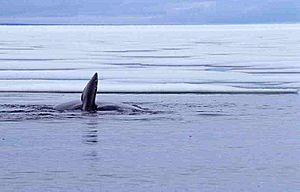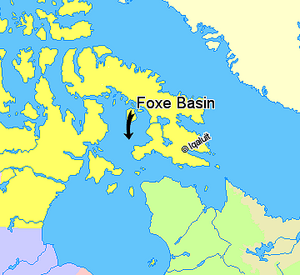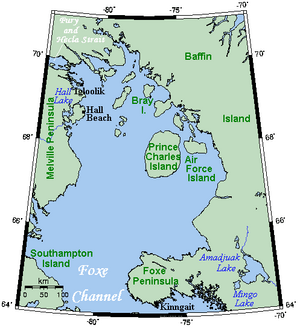Foxe Basin facts for kids
Foxe Basin is a large, shallow area of ocean in Nunavut, Canada. It's located north of Hudson Bay, between Baffin Island and the Melville Peninsula. For most of the year, this basin is covered by sea ice. This ice can be "fast ice," which is stuck to the land, or "drift ice," which floats freely in pieces called ice floes.
The cold waters in Foxe Basin are full of nutrients. This makes them a great place for tiny ocean plants called phytoplankton to grow. Many islands in the basin are important homes for birds, like Sabine's gulls and different types of shorebirds. Large bowhead whales also travel to the northern part of the basin every summer.
The basin is named after an English explorer, Luke Foxe. He explored the southern part of this area in 1631.
About the Waterway
Foxe Basin is mostly a shallow area of ocean. Its depth is usually less than 100 meters (330 feet). However, in the southern part, it can be as deep as 400 meters (1,300 feet). The ocean's tides change a lot in the southeast, by about 5 meters (16 feet). But in the northwest, the tides change by less than 1 meter (3 feet).
Most of the year, the northern part of the basin has "landfast ice," which is ice attached to the shore. Towards the south, there is more "pack ice," which is broken pieces of ice floating together. Foxe Basin rarely becomes completely free of ice until September. Even in summer, it often has open pack ice.
Strong tidal currents and powerful winds keep the ice moving all the time. This movement creates many open water areas called polynyas and long cracks in the ice near the shore, known as shore leads. Because of this constant motion and a lot of dirt in the water, the sea ice in Foxe Basin looks dark and rough. It's easy to tell apart from other ice in the Canadian Arctic.
Foxe Basin connects to other waterways. It joins the Gulf of Boothia through a narrow passage called the Fury and Hecla Strait. It also connects to Hudson Bay and Hudson Strait through the wide Foxe Channel. Another connection is to Repulse Bay and Roes Welcome Sound via Frozen Strait.
The Coastline
The land around the southern part of Foxe Basin is rocky and rugged. In the north, the land is generally low and flat. High cliffs are found in the southern area. Many seabirds build their nests on these cliffs.
In the large, low-lying area of eastern Foxe Basin, there are wide coastal marshes and tidal flats. These muddy areas can be up to 6.5 kilometers (4 miles) wide. You can also find them in the bays of Southampton Island.
Amazing Wildlife

Foxe Basin is a less-known part of the Canadian Arctic. However, it is full of rich and diverse animal life. The many polynyas (open water areas) in the northern basin support a large number of bearded seals. It is also home to Canada's biggest walrus herd, with over 6,000 walruses.
Ringed seals and polar bears are common here. North Southampton Island is one of the places in Canada where the most polar bears build their dens. This area is also an important summer home for bowhead whales, beluga whales, and narwhals. Both bowhead whales and belugas spend their winters in the waters of northeastern Hudson Bay. While bowheads were the only baleen whales known in Hudson Bay, recently, other whales like humpback and minke whales have also been seen migrating into these waters.
The Foxe Basin region is the main home in North America for the Sabine's gull. About 10,000 pairs of these gulls nest here. Moderate numbers of black guillemots, Arctic terns, and different kinds of gulls (like glaucous, herring, and ivory gulls) also breed here.
The Great Plain of the Koukdjuak on Baffin Island is the world's largest goose nesting colony. Over 1.5 million birds nest there. About 75 percent of these are lesser snow geese, and the rest are Canada and brant geese. Many ducks and shorebirds are also found here. Several hundred thousand thick-billed murres breed on the cliffs of Digges Sound and Coats Island to the south.
Images for kids
-
Bowhead whale (Balaena mysticetus), Foxe Basin, July 1999
See also
 In Spanish: Cuenca Foxe para niños
In Spanish: Cuenca Foxe para niños






